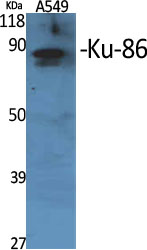CD183 (CXCR3)-FC recombinant protein
- Catalog No.:YD3006
- Reactivity:Human;
- Purity:
- >90% as determined by SDS-PAGE
- Protein Name:
- C-X-C chemokine receptor type 3 (CXC-R3) (CXCR-3) (CKR-L2) (G protein-coupled receptor 9) (Interferon-inducible protein 10 receptor) (IP-10 receptor) (CD antigen CD183)
- Sequence:
- Amino acid:1-53,with FC tag.
- Formulation:
- Phosphate-buffered solution
- Storage Stability:
- -15°C to -25°C/1 year(Avoid freeze / thaw cycles)
- Other Name:
- C-X-C chemokine receptor type 3 ;CXC-R3;CXCR-3;CKR-L2;G protein-coupled receptor 9;Interferon-inducible protein 10 receptor;IP-10 receptor;CD antigen CD183;CXCR3;GPR9;
- Function:
- [Isoform 1]: Receptor for the C-X-C chemokine CXCL9, CXCL10 and CXCL11 and mediates the proliferation, survival and angiogenic activity of human mesangial cells (HMC) through a heterotrimeric G-protein signaling pathway (PubMed:12782716). Binds to CCL21. Probably promotes cell chemotaxis response. Upon activation by PF4, induces activated T-lymphocytes migration mediated via downstream Ras/extracellular signal-regulated kinase (ERK) signaling.; [Isoform 2]: Receptor for the C-X-C chemokine CXCL4 and also mediates the inhibitory activities of CXCL9, CXCL10 and CXCL11 on the proliferation, survival and angiogenic activity of human microvascular endothelial cells (HMVEC) through a cAMP-mediated signaling pathway (PubMed:12782716). Does not promote cell chemotaxis respons. Interaction with CXCL4 or CXCL10 leads to activation of the p38MAPK pathway and contributes to inhibition of angiogenesi
- Subcellular Location:
- [Isoform 1]: Cell membrane ; Multi-pass membrane protein .; [Isoform 2]: Cell membrane ; Multi-pass membrane protein .
- Expression:
- Isoform 1 and isoform 2 are mainly expressed in heart, kidney, liver and skeletal muscle. Isoform 1 is also expressed in placenta. Isoform 2 is expressed in endothelial cells. Expressed in T-cells (at protein level).

